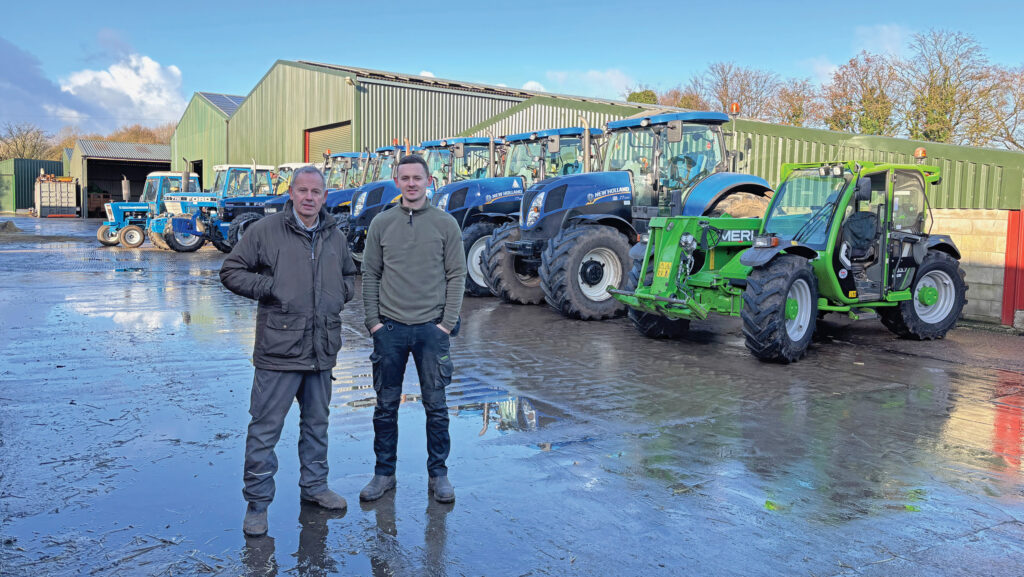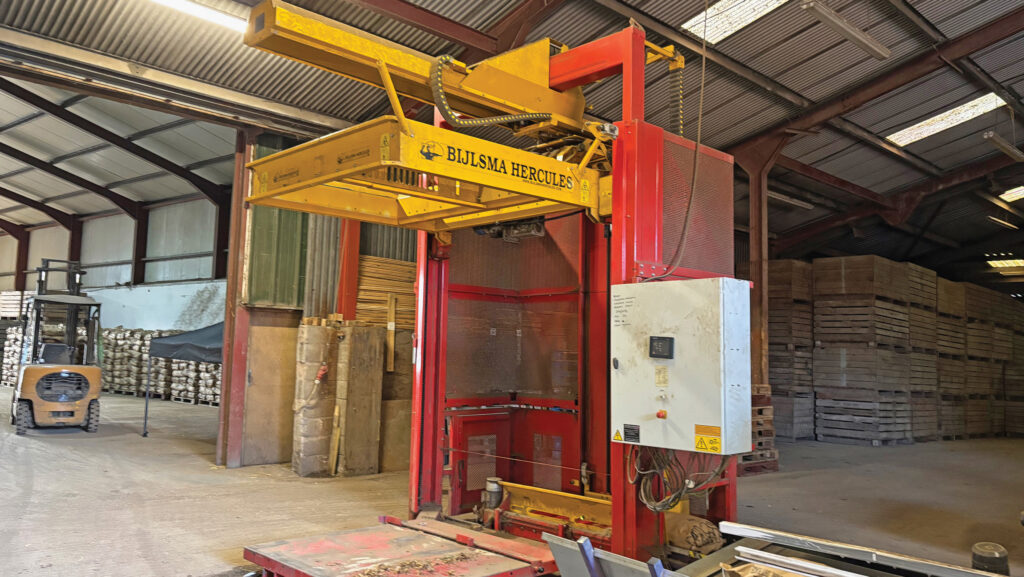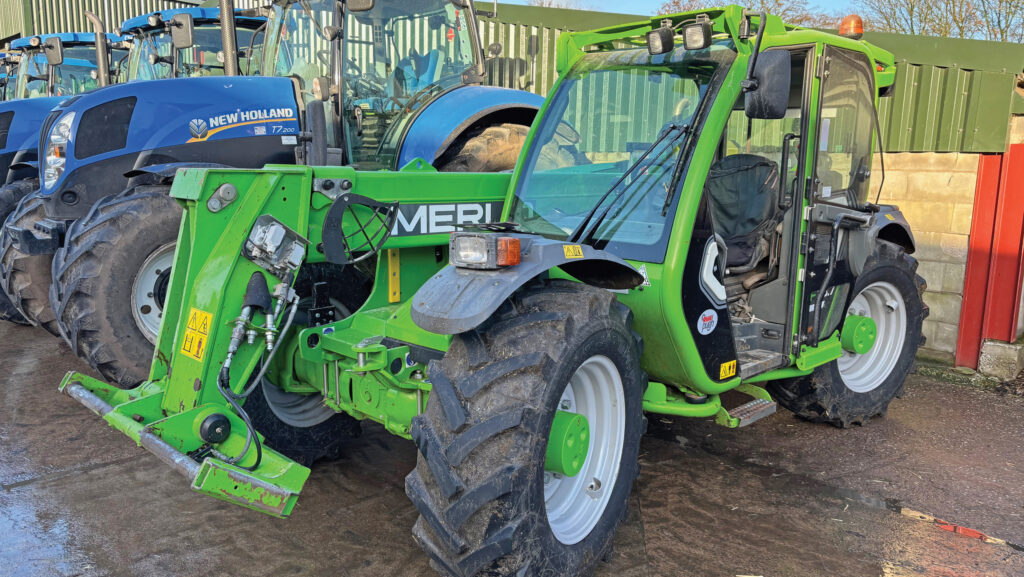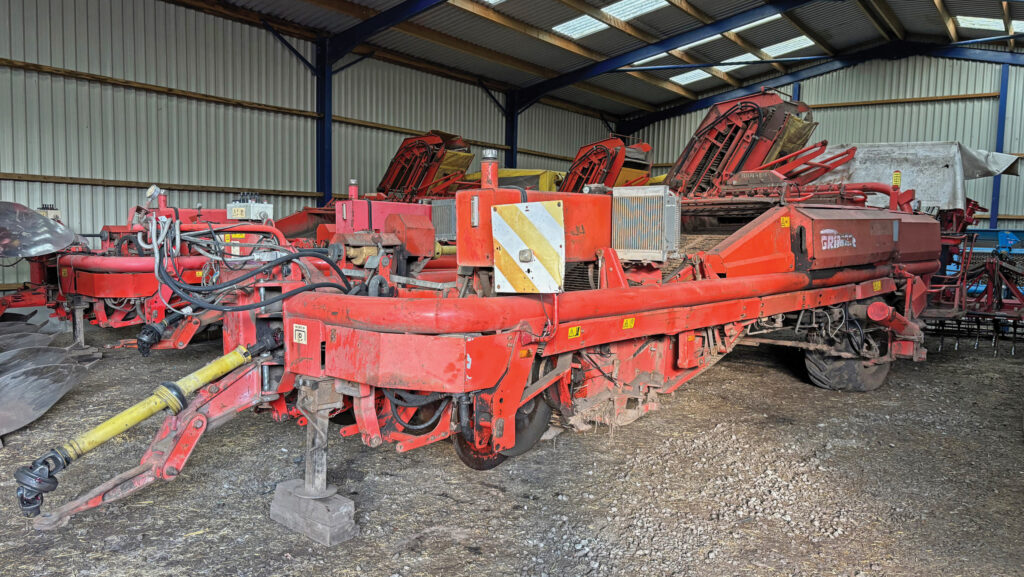What’s in Your Shed? visits a Cheshire beef and spud farm
 Pete (left) and Will Moseley © James Andrews
Pete (left) and Will Moseley © James Andrews A horde of modern classic Ford and New Holland tractors is delivering the goods for Cheshire spud growers Pete and Will Moseley.
We headed over to pose the questions.
See also: 6 high-hour tractors still going strong on progressive dairy farm
Farm facts
- Size 145ha
- Cropping 20ha early and 40ha main crop potatoes sold off the farm to chip shops in 25kg bags, winter barley, maize and grass
- Livestock Approx 110 store cattle for fattening, 50% of which are bull beef
- Staff Pete and Will plus one full-time and another part-time
How brand loyal are you?
We’ve currently got nine Ford and New Holland tractors and have rarely had a different brand on the farm, so we’re pretty loyal. It’s just the old Massey Ferguson 135 that stands out from the crowd.
The obsession with blue paint started with Pete’s dad, who ran both a Fordson Major and Super Dexta before upgrading to a pair of Ford 4000s.
We then moved onto 6600s and 7710s and eventually New Holland TMs, T6000s and T7s. Many of them have been here for years, but they all get used regularly – not one is a museum piece.
Although we’re big fans of the brand, one of the main reasons we’ve got them is because there have been some great dealers in this area over the years.
In the early days we dealt with GW Lea at Nantwich, then Pat Atkinson, and now we go to JR Tomkinson & Sons at Market Drayton.
Favourite dealer?
John Tomkinson (JR Tomkinson and Sons). He’s our go-to man for Ford/New Holland tractors and will always find a good example of a model we’re looking for.
We also like dealing with John Bownes, and Jeff and Matthew Starkey are invaluable for helping us keep the kit running.
Favourite piece of kit?
It’s got to be our Bijlsma Hercules automatic pallet stacker, which has transformed the potato-packing process.
It used to be a three-man job, but since we got this machine in 2020, and an automatic stitcher a couple of years earlier, one person can now do it.
We bought the stacker second-hand from a farm near Cambridge and it cost us £35,000, which has turned out to be a wise investment.
It’ll easily keep pace with the bagging machine – stacking 40 bags to a pallet – allowing us to process about 9t an hour.

Bijilsma Hercules © James Andrews
And your least favourite?
We used to have a 9ft Vicon mower conditioner that went through bed bearings for fun and gave more than its fair share of drivetrain troubles.
We rebuilt it five times in the 10 years we had it, before replacing it with a Pottinger Novacat that has been as good as gold.
Best piece of potato equipment?
Our 3m Standen Powavator blade rotavators, which are a huge improvement over the Howard spike models we were running before.
The blades do a far better job and they’re built seriously tough so should stand the test of time. We bought one a year to help spread the cost and now have three.
Latest purchase?
The T7.200 is our most recent buy, which arrived in June last year.
We hired it first as we needed a bit more power on the rotavator, and we liked it so much that we kept it.
The power is part of the appeal, but it’s the only tractor we’ve got with a 50kph transmission which is a real bonus on trailer work. It’s also in good condition and rides on some nice big tyres.
We bought it from John Tomkinson for £35,000; it’s a 2014 model with 7,400 hours on the clock.
Oldest machine still at work?
Probably the MF 135, which we’ve had since the 1970s. When we had cows it was on daily scraping duties, but it now just gets used for tidying up the yard.
Reliability has always been excellent and we’ve never had to do much to it, apart from when we took it to Abersoch to get a friend’s boat out of the sea, which stuffed the clutch.
In the shed
- Tractors New Holland T7.200, T7.185, TM155, TM130 and T6070; Ford 8340, 7710 Series II, 6600 and 4000; Massey Ferguson 135
- Telehandler Merlo TF 33.7
- Cultivators Lemken five-furrow plough x2, Proforge Maxtilla tine cultivator
- Potato kit Standen rotavator x3, Kuhn rotavator, Standen Pearson bed former, Standen Pearson Megastar Actiflow destoner x2, Techneat front-mounted fertiliser applicator, Reekie Big Box planter, Standen Eho tray planter, KS 75-2 haulm topper, Grimme DL 1700 harvesters x4, Squire grader, Tong box grader, Agrimech Themis potato bagger, Bijlsma Hercules pallet stacker
- Grass kit Pottinger Novacat 305H mower conditioner, Kuhn GF5902 six-row tedder
- Other Nugent livestock trailer, Griffith 10t trailer x6, Richard Western 12t trailer, Amazone ZA-M 1001 fertiliser spreader, Allman 12m sprayer
How long do you keep your machines?
We don’t change them very often. Most of the tractors have been with us for years, but we do upgrade them every now and again, usually when we see something nicer come up for sale.
The fact that we’ve got so many means hours and reliability aren’t a big concern – we can always hop on another if one gives trouble. But most of them are so simple that they rarely give us any issues.
If we were to make a change, the 8340 might be next as it’s the highest-hour frontline tractor, with 12,000 on the clock. The only one on more than this is our 6600, which has done 13,000.
The telehandler is the sole exception to this rule as we give it so much work moving potatoes around and feeding/bedding down cattle.
We like Merlos as they’re smooth, compact and handy around the yard. The current model is a 33.7, which is very neat for a machine with a 7m reach that can lift 3.3t.
They tend to clock about 1,000 hours a year and we change them every three years before they depreciate too much.

Merlo TF33.7 C © James Andrews
Next on your wish list?
Money no object, it would be nice to have a self-propelled potato harvester. As well as giving some extra output, the tracks and larger separation area would allow us to keep going in wetter conditions.
A two-row Grimme Varitron would be our model of choice, which you can pick up second-hand for about £150,000 these days.
Biggest machinery mistake?
Years ago, we were taking a Grimme potato harvester down the road and someone had forgotten to put the latch pin in the elevator.
It swung round and smacked into a tree, and it took us two days to straighten it enough to get going again.
Most expensive repair bill?
We had an oil leak on the Merlo 33.7 where pipes in the boom had been rubbing together. It was just out of warranty and we got a bill for £2,800 to replace them.
Most overpriced spare part?
The two oil pipes in the Merlo’s boom, one of which was £600 and the other £800. They just looked like regular lengths of hydraulic hose, so it’s crazy they can charge that much for them.
What couldn’t you live without in the workshop?
We recently got a big petrol Husqvarna backpack leaf blower which is fantastic for keeping the yard clean.
What’s your everyday transport?
We’ve got a couple, one of which is a Land Rover Defender 110 double-cab pickup that we bought second-hand from Ireland in 2018.
It’s about the newest you can get with a TD5 engine and is really tidy, but we nearly came a cropper as it still had £3,500 on finance. Thankfully we did an HPI check first, so we made sure the seller coughed up before we did the deal.
There were 8,500 miles on the clock and we only paid £8,500 as it was just before the prices got silly. We’ve done another 40,000 miles and it’s been great.
The other is a Mercedes X250D pickup which we bought after seeing one at Agritechnica. It might be based on a Nissan Navara, but it’s far more comfortable and better finished.
Best tractor you’ve ever had?
The TM130 has been fantastic – a huge step up in power and comfort from the 7810 Series III we were running before, and ultra reliable.
It’s only the second tractor we’ve bought new and, given the huge inflation in machinery prices, very likely the last.
Back in 2006 it cost about £30,000 – £5,000 less than the 2014 T7.200 we’ve just bought – and isn’t far off that value now.
We’ve never done any significant work on it, other than routine servicing, and we haven’t had to do the injectors, unlike the TM155.
It’s now clocked 8,700 hours and most of its time these days is spent running a destoner or harvester.
And the worst?
The Ford 7810 mentioned above. They’re generally great tractors, but the engine in this one was never quite right.
It always ran hotter that it should and we had to fit two head gaskets in the six years we had it. It was fine other than that, but we couldn’t get to the root of the problem, so we traded it in for the TM130.
We also had the block go porous on a two-wheel-drive 7710 we had a while back. That was swapped for the four-wheel drive 7710 Series II we have now, which has been a brilliant tractor.
This has clocked 7,900 hours and is still used regularly.
Most surprisingly useful feature on a machine?
Both the T6070 and T7.185 have got engine load readouts, which are really useful when we’re pushing the tractors hard on jobs such as rotavating.
If they’re getting near peak output, we’ll back off a bit so we aren’t putting undue strain on them. Without this you’re just guessing really.
Most pointless piece of technology?
We’re all about running older, simpler tractors that have less to go wrong, so most new technology is lost on us.
Things have got a bit more sophisticated with the T7s, but ours have got a fairly basic spec and no GPS.
Biggest machinery bargain?
Our four Grimme DL 1700 potato harvesters have all been bargains, costing between £3,000 and £5,000 each.
This is about the going rate, as we bought them all from Steve Thorley Potato Equipment, but it’s amazing that they’re so cheap given that new ones cost about £200,000.
Ours are all from the late 1990s/early 2000s and they’ve been really reliable. The only thing we need to watch out for is the tension on the bed chains.
Having four is handy in peak season, as we can leave them on different farms and significantly reduce the amount of time spent moving kit about.

Grimme GL1700 harvester © James Andrews
Biggest bugbear?
The cost of new tractors is so high relative to farm incomes that businesses such as ours were priced out of them long ago.
Luckily, we enjoy running older models, because we don’t really have much choice.

